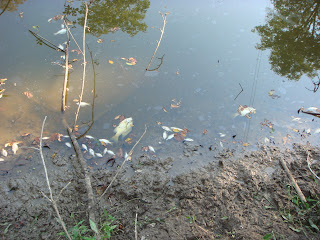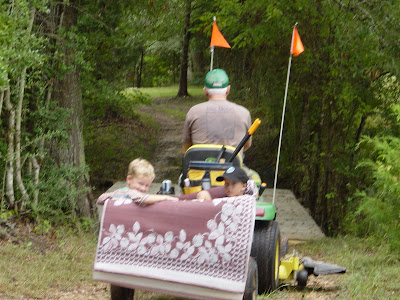Our neighbor’s pasture is adjacent to ours and not fenced from our property since we jointly own the cattle herd with the neighbor and the cattle run freely over both properties. The property line is marked by the surveyor’s stakes when the combined 80-acre track was subdivided into our 40-acre track and the neighbor’s 40 acres. Last March, the neighbor lightly disked his pasture. We’ve watched with interest the progress of the grass on his side of the property line all spring and summer. In late summer, the grass in his pastures put-up tall stems with seed heads that waive in the breeze. Now the grass is a light tan color and looks like amber waves of grain. Its pretty and, I admit, we developed a bit of "grass-envy." The entire disked pasture consists of this grass with the tall stems and turkey-foot seed heads. There are very few other grasses or plants in his pasture now.
Our pasture right next to his is full of flowering weeds. Weeds three feet high, some with white flowers, some with little yellow flowers and a pale green leafy plant dominate. There is also some grass of the type on the neighbor’s place and a few other grasses. When we drive through the pasture on the Ranger or ATV, we stir-up bugs, grasshoppers and birds. One time we surprised a white-tailed deer doe and her fawn hiding in the weeds. Inevitably, one or both of us starts to sneeze! Our pasture is somewhat unsightly with weeds the cows won’t eat.
As we stood with Larry and Stephanie on the property line they compared the pastures, Larry from an agricultural perspective and Stephanie from a wildlife perspective. They quickly identified the grass on the neighbor’s place is King Ranch bluestem (Bothriochloa ischaemum, var songarcia). The name sounds very Texas-ish but don’t let the name or good looks fool you. Larry explained that KR Bluestem is a noxious invasive grass imported from Asia and Central Europe. It was primarily brought into South Texas (by the King Ranch folks) in the 1920s and 1930s for its drought resistant qualities. When cotton farming declined in Washington County, Texas due to economics and a cotton root fungus in the soil, KR bluestem was introduced to prevent erosion. According to Larry, folks at the time thought that KR bluestem would save the soil, save the county, save Texas and thus save the world!
 |
| King Ranch Bluestem |
Asked how to control KR bluestem, Larry explained that so far researchers have not found an effective means to control the grass. Sprays of extremely high Round-Up concentrations can knock it back but the grass tends to grow back. Other usual methods of controlling grasses have not been successful in controlling KR bluestem. Research continues.
Turning to our pasture, Stephanie explained that from a wildlife standpoint, our pasture was a good habitat for prairie birds. She pointed to three good seed sources: common broomweed (Xanthocephalum dracunculoides), snow-on-the-prairie (Euphorbia bicolor) and Texas croton (Croton texensis). Broomweed and croton are forbs, which are non-woody flowering broad leaf plants that are not grass. Snow-on-the-prairie is a euphorbia, kin to succulents and poinsettias. The white “flower” giving the plant its name “snow on the prairie” is not really a flower but is nonetheless referred to as a “wild flower”.
 |
| Texas Croton |
 |
| Broomweed |
 |
| Snow-on-the-prairie |
After talking with Larry and Stephanie, we’ve decided that we don’t want encourage the KR bluestem to take a stronger grip on our pasture. Eventually we plan to convert the pasture to native prairie grasses that both cattle and wildlife prefer. We realize now that this may be an even bigger challenge than we anticipated as first we have to knock back the KR bluestem enough for other grasses to have a chance. Then the restoration area must be fenced off from the cattle who will eat the new grass as it comes up preventing the grass from becoming established.
Larry and Stephanie also discussed state and federal programs available to assist landowners with certain agricultural and wildlife activities. We are going to look into those in more detail. They also strongly recommended that we meet with a local representative from the U.S. Department of Agricultural who they say is the most knowable about soil and erosion concerns and federal programs to assist landowners with these issues. We have some erosional features on the property that we need to address.
We also inquired about why, over the last 18 months, large mature oak trees that looked healthy on Old Dogwood fell over, full of green leaves. Larry’s suspicion is a cotton root rot fungus that still infects the soil in the area from days when cotton was king. He also suggested we get the local U.S. Forestry Service representative out to look at the woods on Dogwood Ranch which he believes are unique in area.
I am now reaching out to those federal resources to investigate further what we should or should not do with the land and what assistance, if any, is available to assist us (without too many federal government strings attached!).




















